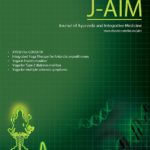Saeed Ahmada, Tayyeba Rehman Waheed Mumtaz Abbasi
In vivo evaluation of antipyretic effects of some homeopathic ultra-high dilutions on Baker’s yeast-induced fever on Similia principle
J Ayurveda Integrative Med, 2018, 9 (3), 177-182

Background – Homeopathy is a controversial alternative system of medicine. The action of homeopathic medicines is considered slow and it is assumed that homeopathic medicines are ineffective in acute conditions such as fever. Objective – In the present study, effects of 3 homeopathic medicines on baker’s yeast induced fever were investigated. Materials and methods – 42 local strain rabbits were equally divided into 7 groups. Normal saline was orally administered to group 1 (normal control) rabbits without fever induction. Group 2 underwent baker’s yeast-induced fever (negative control). Groups 3, 4, 5, 6 and 7 underwent baker’s yeast-induced fever and were thereafter treated orally with paracetamol, Nux vomica 200C and 1M, Calcarea phos 200C and Belladonna 200C respectively. Rectal temperature was checked hourly. The abdominal writhing and frequency of loose stools were also monitored. ANOVA was applied for checking statistical significance. p ≤ 0.05 was considered significant. Results – The rectal temperature increased significantly (p < 0.05) in the negative control group when compared to the normal control. Abdominal writhing and loose stools monitoring showed increased writhing and loose stools frequency of group 2, 3, 6 and 7 rabbits. However, treatment of paracetamol significantly reduced rectal temperature. Group 4 & 5 showed significant reduction of rectal temperature together with abatement of abdominal writhing and loose stools. Conclusion – N. vomica ultra-high dilutions have normalized rectal temperature and prevented the abdominal writhing and loose stools in baker’s yeast-induced fever model of rabbits. It could be due to antidotal activity of N. vomica ultra-high dilutions. Therefore, N. vomica ultra-high dilutions can be useful antipyretic agents and can treat conditions associated with gastrointestinal symptoms. However, fixed conclusion can’t be asserted due to caveat of small sample size.






Lascia un commento
Devi essere connesso per inviare un commento.